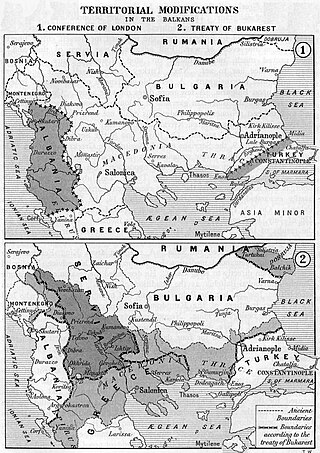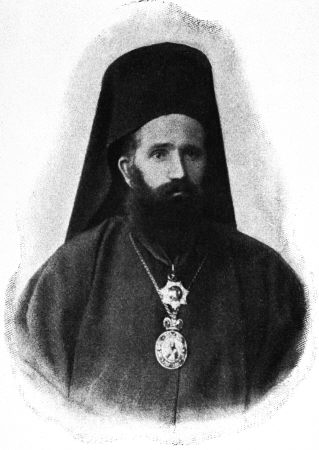
Korçë is the eighth most populous city of the Republic of Albania and the seat of Korçë County and Korçë Municipality. The total population of the city is 51,152 and 75,994 of Korçë municipality, in a total area of 806 km2 (311 sq mi). It stands on a plateau some 850 m (2,789 ft) above sea level, surrounded by the Morava Mountains.

Northern Epirus is a term used to refer to those parts of the historical region of Epirus, in the western Balkans, which today are part of Albania. The term is used mostly by Greeks and is associated with the existence of a substantial ethnic Greek minority in the region. It also has connotations with irredentist political claims on the territory on the grounds that it was held by Greece and in 1914 was declared an independent state by the local Greeks against annexation to the newly founded Albanian principality.

The Treaty of London (1913) was signed on 30 May following the London Conference of 1912–1913. It dealt with the territorial adjustments arising out of the conclusion of the First Balkan War. The London Conference had ended on 23 January 1913, when the 1913 Ottoman coup d'état took place and Ottoman Grand Vizier Kâmil Pasha was forced to resign. Coup leader Enver Pasha withdrew the Ottoman Empire from the Conference, and the Treaty of London was signed without the presence of the Ottoman delegation.
The postal history of Northern Epirus, a region in the western Balkans, in southern modern Albania, comprises two periods; 1912–1916 and 1940–41. Northern Epirus was under Greek administration during the First Balkan War (1912–1913), but it was then awarded to the newly founded Albanian state by the Florence Protocol (1913). During this period, Greek stamps were used. Greece withdrew from the region in early 1914. The people of Epirus were unwilling to be part of Albania, though, and launched a revolution. Under a provisional government, the independent Northern Epirus was formed in February 1914 and it eventually managed to gain full autonomy under nominal Albanian sovereignty, according to the Protocol of Corfu. Northern Epirus operated its own postal service and issued postage stamps, both official and unofficial, during that year.

Georgios Christakis-Zografos was a Greek politician, minister of foreign affairs and president of the Autonomous Republic of Northern Epirus (1914).
The Northern Epirus Liberation Front, also called the Northern Epirote Liberation Organization, was an ethnic Greek resistance group that operated in areas of southern Albania during the Italian and German occupation of Albania (1942–1944). The group operated after the withdrawal of the Greek forces from the area, against the invading Italians, Germans and both against the Albanian communist and collaborationist organizations.
The Greeks in Albania are ethnic Greeks who live in or originate from areas within modern Albania. They form the largest minority group in the country. They are mostly concentrated in the south of the country, in the areas of the northern part of the historical region of Epirus, in parts of Vlorë County, Gjirokastër, Korçë, and Berat County. The area is also known as Northern Epirus. Consequently, the Greeks hailing specifically from Southern Albania are also known as Northern Epirotes. The Greeks who live in the "minority zones" of Albania are officially recognised by the Albanian government as the Greek National Minority of Albania.

The Autonomous Republic of Northern Epirus was a short-lived, self-governing entity founded in the aftermath of the Balkan Wars on 28 February 1914, by the local Greek population in southern Albania.

Spyros Spyromilios was a Greek Gendarmerie officer and guerilla fighter who took part in the Greco-Turkish War of 1897, the Greek Struggle for Macedonia, and the Balkan Wars. In 1914 he proclaimed the Autonomy of his native town, Himarra, and joined the autonomist struggle of Northern Epirus against its inclusion within the newly established Principality of Albania.

Alexandros Karapanos was a Greek politician and diplomat. He was born in Arta (Epirus) and died in Athens.

The Protocol of Corfu, signed on May 17, 1914, was an agreement between the representatives of the Albanian Government and the Provisional Government of Northern Epirus, which officially recognized the area of Northern Epirus as an autonomous self-governing region under the sovereignty of the prince of the newly established Principality of Albania. The agreement granted the Greeks of the districts of Korytsa (Korçë) and Argyrokastro (Gjirokastër), which form Northern Epirus, wider religious, educational, cultural and political autonomy, inside the borders of the Albanian state.

Dimitrios Doulis, was a Greek military office, minister of Defence of the Autonomous Republic of Northern Epirus. He was from Nivica in modern southern Albania.

The participation of Greece in the Balkan Wars of 1912–1913 is one of the most important episodes in modern Greek history, as it allowed the Greek state to almost double its size and achieve most of its present territorial size. It also served as a catalyst of political developments, as it brought to prominence two personalities, whose relationship would dominate the next decade and have long-lasting repercussions for Greece: the Prime Minister Eleftherios Venizelos, and the Army's commander-in-chief, the Crown Prince and later King, Constantine I.

Bishop Vasileios of Dryinoupolis was a Greek metropolitan bishop, scholar, important figure of the Northern Epirus movement and member of the provisional Government of Northern Epirus (1914).

The Himara Revolt, was a Greek uprising during the First Balkan War that took place in the region of Himara, on November 18 [O.S. November 5] 1912. It successfully overthrew the Ottoman forces of the region, thus securing the coastal area between Sarandë and Vlorë for the Hellenic Army.

In World War I, Albania had been an independent state, having gained independence from the Ottoman Empire on 28 November 1912, during the First Balkan War. It was recognised by the Great Powers as the Principality of Albania, after Turkey officially renounced all its rights in May 1913. Being a fledgling new country, it quickly unravelled and just a few months after taking power, its German ruler, Prince Wilhelm, was forced to flee. After World War I broke out, anarchy took hold of the country as tribes and regions rebelled against central rule. To protect the Greek minority, Greek control was established in the southern districts replacing the Northern Epirote units beginning in October 1914. In response to this, Italy, although officially neutral at the time, also sent troops into the port of Vlorë, while Serbia and Montenegro took control of northern regions. In 1915 Serbia was overrun by combined German, Austro-Hungarian, and Bulgarian forces; the Serbian army retreated across the mountain passes of northern Albania, towards the Adriatic. Italian troops drove the Greeks from southern Albania and brought almost all Albanian territory under their control. Austrian forces invaded in June 1916; Austro-Hungarian forces remained in Albania until the end of the war when a multinational Allied force broke through and pushed them out in 1918.

The Northern Epirote Declaration of Independence occurred on February 28, 1914, as a reaction to the incorporation of Northern Epirus into the newly established Principality of Albania. The region of Northern Epirus, which corresponds to modern-day southern Albania, came under the control of the Greek forces during the Balkan Wars of 1912–13. However, the subsequent Protocol of Florence assigned it to the newly established Albanian state, a decision that was rejected by the local Greek population. As the Greek army withdrew to the new border, a Panepirotic Assembly was organized by the representatives of Northern Epirus in Gjirokastër. Given the fact that union of Northern Epirus with Greece had already been dismissed by the European Great Powers, they decided that only autonomy or alternatively an international occupation would be appropriate for the region. Finally, Georgios Christakis-Zografos, the head of the assembly, declared the independence of the Autonomous Republic of Northern Epirus.

The Pan-Epirotic Assembly of Delvino was a meeting of the representatives of the Autonomous Republic of Northern Epirus, in June–July 1914, that ratified the Protocol of Corfu. The latter agreement granted an autonomous status for Northern Epirus, as well as a number of rights for the local Greek populations, inside the borders of the newly established Principality of Albania.

Georgios Soulios was a Greek guerrilla fighter of the early 20th century. He participated in the Macedonian Struggle, the Balkan Wars, and in the struggle for the establishment of the Autonomous Republic of Northern Epirus.
Epameinondas Charisiadis was a Greek revolutionary of the Northern Epirus movement, politician and doctor.




























